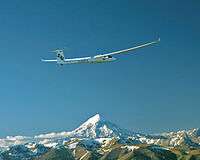Stemme S10
|} The Stemme S10 is a self-launching sailplane produced by Stemme AG in Strausberg (Germany) since the 1980s. The engine is mounted amidships and it features an unusual folding propeller which is stowed inside the aircraft's nose-cone when the engine is not in use.
Design and development
The Stemme S10 also has several unusual features such as a tailwheel undercarriage and a side-by-side cockpit. It does not have a tow hook connection so it must self-launch. The two main wheels retract and lower electrically, though they can also be lowered manually if needed. There is an option to fold wings to reduce hangar span to 11.4 m (37 ft 5 in). The engine restart time is 5 seconds. A solar panel can provide additional electrical power during long flights. It has a steerable tailwheel, Schempp-Hirth spoilers and optional winglets. The current variant, the S10-VT, has a variable-pitch propeller which allows more power during take off, and a new turbocharged Bombardier Rotax 914F engine in place of the earlier Limbach L2400. Most parts are made in Poland, but future production will be handled by Remos Aircraft.[1]
First seen at the 1996 Berlin Air Show, the S15 variant has a span reduced to 20.0 m (65 ft 7 in) and has two underwing hardpoints for scientific or surveillance sensor pods. There is also an unpiloted version, the S-UAV, again intended for surveillance.
Operational history

Atmospheric measurements were made with S10 VT during the Mountain Wave Project (MWP) Expedition Argentina'99 1,550 km (963 mi) record flight to Tierra del Fuego[2] and during Expedition Mendoza 2006, when scientific measurements of atmospheric turbulence were made up to 12,500 m (41,010 ft) around and over the highest mountain of the Americas, Aconcagua.[3]
An S10 was flown by Klaus Ohlmann as a pure glider for a record distance of 2,463 km (1,530 mi) , in a 14-hour flight.
Two examples were used by the United States Air Force Academy between 1995 and 2002 under the designation TG-11A.
Variants
- S10
- Standard production variant.
- S10VC
- Surveillance variant with underwing sensor pods.
- S10-VT
- 115hp Turbocharged Rotax 914F power.[4]
- TG-11A
- S10s operated by the U.S. Air Force Academy
Specifications (S 10-VT)
.jpg)
Data from Jane's All The World's Aircraft 2003–2004.[5]
General characteristics
- Crew: 1 pilot
- Capacity: 1 passenger
- Length: 8.42 m (27 ft 7 in)
- Wingspan: 23.00 m (75 ft 6 in) (excluding winglets)
- Height: 1.80 m (5 ft 11 in)
- Wing area: 18.70 m2 (201.3 sq ft)
- Aspect ratio: 28.3
- Empty weight: 645 kg (1,422 lb)
- Gross weight: 850 kg (1,874 lb)
- Powerplant: 1 × Rotax 914 F2/S1 turbocharged flat-four engine, 84.6 kW (113.5 hp)
- Propellers: 2-bladed
Performance
- Cruise speed: 259 km/h (161 mph; 140 kn)
- Stall speed: 78 km/h (48 mph; 42 kn)
- Never exceed speed: 270 km/h (168 mph; 146 kn)
- Range: 1,730 km (1,075 mi; 934 nmi) (maximum fuel)
- Service ceiling: 9,140 m (29,990 ft)
- g limits: +5.3/-2.65
- Maximum glide ratio: 50
- Rate of climb: 4.0 m/s (790 ft/min)
References
- ↑ Thurber, Matt (1 September 2014). "AirVenture Report: 2014". ainonline.com. Retrieved 24 January 2015.
- ↑ Scientific TV-feature (RBB GEO-documentation) „Rodeo in the Sky - Research for greater flight safety“
- ↑ Heise, Rene (2011), "The sailplane as research laboratory – turbulence measurements above the Andes" (PDF), European Meteorological Calendar 2011, European Meteorological Society, retrieved 20 April 2011
- ↑ Thomas Horne. "Power Sailing". AOPA Pilot: 58.
- ↑ Jackson, Paul (2004). Jane's All the World's Aircraft 2003-2004. Coulsdon, Surrey, United Kingdom: Jane's Information Group. pp. 176–177. ISBN 0-7106-2537-5.
External links
| Stemme S10 | |
|---|---|
.jpg) | |
| A Stemme S10 taking off | |
| Role | motor glider |
| National origin | Germany |
| Manufacturer | Stemme AG |
| Introduction | 1984 |
| Unit cost |
$400,000[1] |
| Wikimedia Commons has media related to Stemme S10. |
- Manufacturer's website
- USAF AETC website
- Mountain Wave Project website with FAI-world records - S10 VT